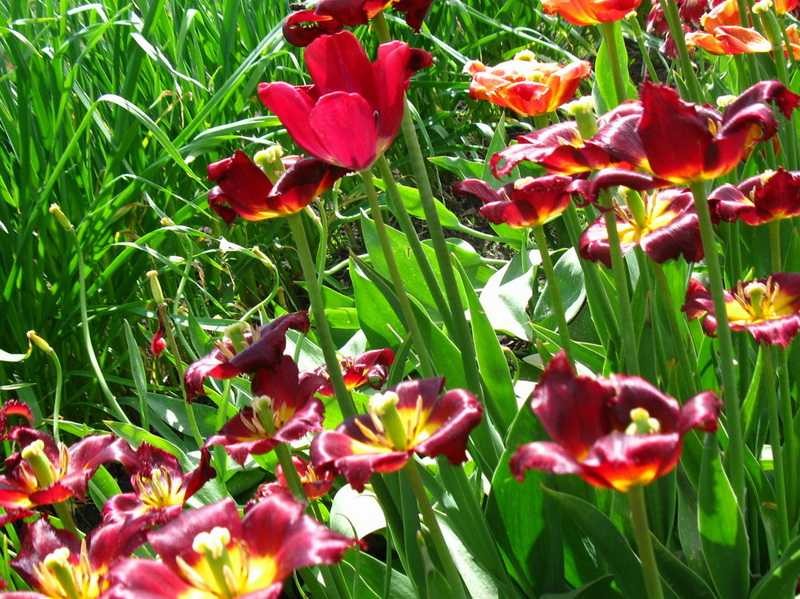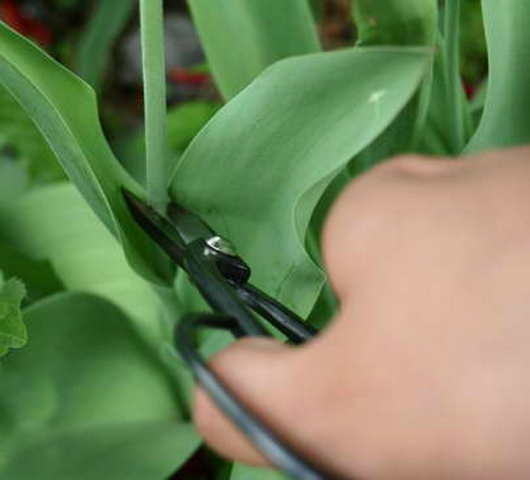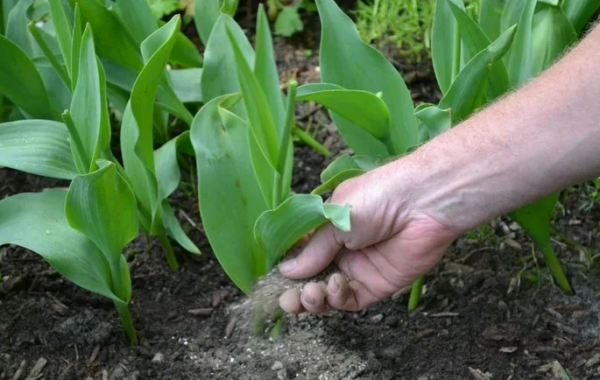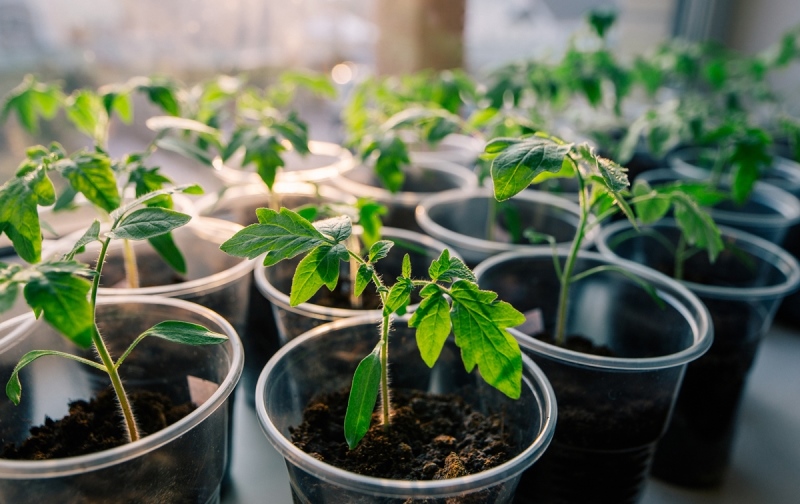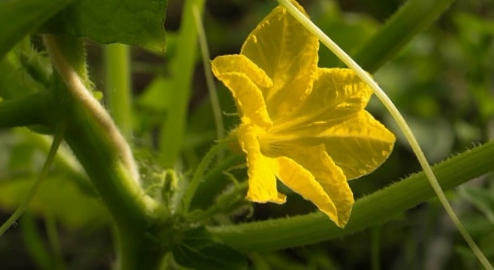Content:
Tulips are very beautiful and delicate flowers that symbolize the beginning of spring. These spring plants serve as a decoration for homes, summer cottages, garden plantations, city flower beds and parks. The tulip belongs to the Liliaceae family and is a bulbous perennial plant. The plant reaches an average height of 10 cm, its stem is straight, and most of the classes and varieties release only one bud.
To date, breeders have bred varieties that produce three or more flowers. It is worth noting that tulips have a very diverse color; they can be crimson, white, yellow, burgundy, lilac and even black. These flowers have a fairly short flowering period. Many are interested in the question - what to do with the tulips after they have faded, how to care for them further?
When tulips bloom
Tulips, which are intended to be grown in a park or garden, have an active flowering period in the second half of April and lasts until May. Many people are engaged in the cultivation of flowers for the purpose of further sale, so you can find tulips on store shelves throughout the year.
With the onset of spring, florists begin to create amazing bouquets using these flowers. With the help of various technologies for growing flowers in the greenhouse, early flowering of tulips can be achieved, but the optimal period for plant flowering is still mid-spring.
Caring for tulips after flowering outdoors
After the culture begins to fade, you need to resort to removing wilted peduncles. This procedure is necessary in order not to allow the plant to waste energy to ensure that the seeds are finally ripe. In this situation, due attention should be paid to the plant bulbs - if they have received all the necessary nutrients in sufficient quantities and have reached the peak of their ripeness, then in the next season they will give lush and large flowers.
After the tulips have bloomed, they need to provide increased watering, which should last at least two weeks. During this time, the plant intensively accumulates nutrients from the soil, namely:
- calcium;
- sulfur;
- iron;
- manganese;
- copper and zinc.
The main nutrients for tulips are cobalt, hydrogen, oxygen, nitrogen and phosphorus. The culture absorbs these compounds with the help of the root system from the soil, as well as with the help of foliage. The air contains nitrogen, oxygen and carbon, which is necessary for the active life of the plant.
Tulips have faded, what to do next with them
Florists who are just starting to grow tulips often make mistakes, one of which is that the bulbs of the plant remain in the ground throughout the summer.
This fact is due to the fact that tulips that were left in the ground, buds decrease over time, and the stems become shortened and thinned. When “babies” appear on the mother's bulb, it goes deeper into the ground, and pushes the “babies” to the surface of the earth. By the next year, gardeners are already getting flowers of these very "babies", and not the mother's bulb, which was buried in the soil.
You should pay attention to the aerial organs of tulips: as soon as the natural process of drying of the leaves begins, and the stem can be easily wrapped around your finger, the bulbs must be dug out. Experienced flower growers recommend using a bayonet shovel for these purposes, with the help of which the earth is pushed deeper than the level at which the bulbs sit.
After digging the bulbs out of the ground and before starting drying, you need to disinfect them. This measure is necessary for the prevention and control of pests and diseases. The processing scheme looks like this:
- rinse the bulbs in a container with running water, then soak for 30 minutes in a solution of karbofos (open and use a four percent substance), you can also hold the bulbs for 10 minutes in hot water;
- choose a shaded and dry room, provide good ventilation and spread the bulbs in one layer to dry;
- the drying procedure should last 5 days, after which the tulip bulbs will be sent for long-term storage.
The dug out bulbs must be cleaned of soil residues, roots and old scales, then sort by size and separate those "kids" that will easily move away. The next step: you need to take a trellis pot, pour the culture bulbs there and place in a dry place (an attic or shed will be optimal).
There must be good ventilation in the place where the bulbs are stored, and there must also be weak diffused light. The optimal storage temperature is 20 degrees above zero until the onset of autumn, after which the temperature must be reduced to 17 degrees and adhere to this mark until the very landing in the ground. Once every 7 days, it is imperative to inspect and touch the planting material for the timely detection of diseases and pests.
Bulbs that affect yellow or white spots should be thrown away immediately, as this symptom is the first warning sign of a putrid infection. Before planting tulips in the fall, you need to process the bulbs using a manganese solution for this purpose.
When and how to properly trim tulips after flowering
Experienced flower growers advise to pick off the foliage of the plant with your hands, and not cut it off, and only after it has completely turned yellow. This procedure should be carried out 6 weeks after the tulip has finished blooming. If the leaves are problematic to come off - this indicates incomplete ripening of the bulb, you need to wait a little while the foliage can be easily pulled out of the ground.
If the foliage is torn off prematurely, bulb development will stop, which, in turn, will negatively affect flowering in the next season. In order not to lose sight of the place where the bulbs are located, you need to leave the stem as a mark. When planting tulips with other flowers such as irises, the appearance of the garden will not be spoiled by dry stems and leaves.
Tulips after flowering: what to do and what to feed
As mentioned above, tulips, after they have faded, need to be watered and fed abundantly. After removal of wilted peduncles, fertilizers must be applied over the next 2 weeks, since it is during this period that an increased accumulation of nutrients occurs.
Many people ask themselves what to feed tulips with? It is worth immediately excluding those fertilizers that contain chlorine and nitrogen. In order for the plant bulbs to be better stored, the culture needs to provide a sufficient amount of potassium and phosphorus. Top dressing must be applied under the bushes of plants (use no more than 40 g of fertilizer per 1 square meter). Also, when fertilizing, the use of an aquarium, crystallin or solution can help.
Planting and caring for tulips outdoors in spring after flowering
Many gardeners say that it is possible to plant tulips in the spring season, if it was not possible to do this in autumn due to weather conditions or for any other reason. But in this case, you should not expect a lush flowering, because immediately after planting only a few seedlings are capable of blooming. Planting tulips in spring consists of several key points:
- before planting the bulbs, they must be placed in the refrigerator overnight, and then soaked in a light manganese solution for 30 minutes;
- as soon as the last layer of snow comes off, the bed must be prepared for planting: dig it up with a pitchfork and make furrows, maintaining a distance of 30 cm if the bulbs are large, and 15 cm if children are planted;
- before planting, shed furrows using a hot manganese solution;
- if the soil is very heavy, it can be improved by adding loose fertile soil, river sand or compost;
- as for drainage, it can be strengthened and coarse washed sand can be poured onto the bottom of the grooves (the length of the layer should be 3 cm);
- bury large bulbs into the ground at a distance of 15 cm, and children - by 7 cm, then slightly press them into the ground, fill them up and fence them with a rake or pitchfork.
You need to take care of the tulips immediately after the first sprouts appear from under the ground. Plants that have not sprouted must be destroyed so that they do not harm other flowers. The tulip belongs to the group of moisture-loving plants, but its root system is not able to be fed by groundwater due to its unique structure, therefore it is necessary to water them in a timely manner. The frequency of watering depends on the soil in which the plant grows. Watering should be regular and abundant throughout bud formation and flowering. On average, 1 sq. m it is recommended to use no more than 40 liters of water, but make sure that it does not fall on the foliage, otherwise this will lead to burns.
Do not forget that the soil must be weeded and loosened regularly. It is best to carry out this procedure after the planting has been watered - then the earth will be moist and the weeds will be easily removed. By the way, with regard to weeds, they provoke depletion of the soil and deprive it of nutrients. It is for this reason that it is imperative to fight them. Loosening of the soil is necessary in order to retain moisture in it, as well as prevent weeds.
Special attention should be paid to diseases and pests that can cause significant harm to tulips, and in some cases even lead to death. The greatest danger to this plant is represented by the variegation virus, which is characterized by spots, stripes and streaks.Today, there are no effective means of combating the virus, so in order to avoid such an unpleasant disease, you need to buy bulbs only from trusted sellers.
After the plants have been cut, the tools must be disinfected after each tulip so that the dangerous virus is not transmitted to other plants along with the sap. A culture that has been infected must be immediately dug out along with that lump of soil on the roots, and then burned. Pour a strong manganese solution into the pit.
You definitely need to ask yourself the question when growing flowers in the open field: when the tulips have faded, what to do next? If you properly care for the plant and follow the rules for storing the bulbs, then next spring you can enjoy the abundant flowering of this beautiful ornamental plant.


